Sidekick speed. The most difficult kick in speed to attain. Why?
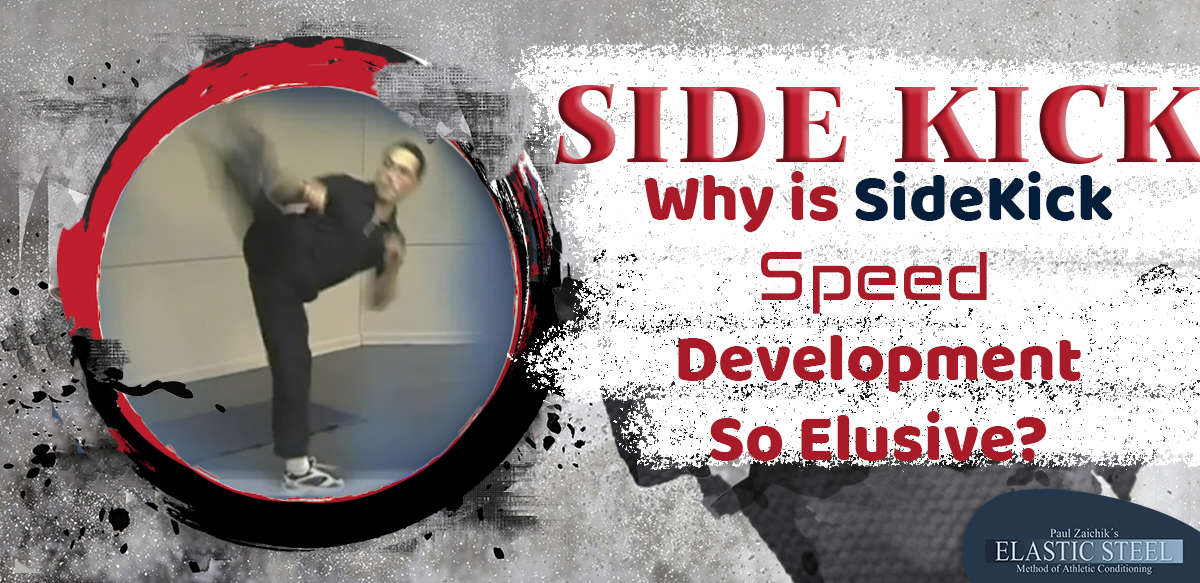
Sidekick speed. The most difficult kick in speed to attain.
Why?
Why?
I've been asked this questions quite a few times and I have thought about it since I began to practice martial arts. When I began to practice the sidekick, I kept pondering on this question. I watched a lot of martial arts practitioners throw a powerful sidekick. But often not a fast one.
There's always this question of how can a sidekick be powerful, if it's not so fast?
Well, a lot of people learn how to put their mass behind the kick. But they don't
actually have the fast movement of the leg. They might even have fast movement
of their body as they step into the kick. But the movement of the leg. It's not
very fast, especially when there is no target.
actually have the fast movement of the leg. They might even have fast movement
of their body as they step into the kick. But the movement of the leg. It's not
very fast, especially when there is no target.
Oftentimes people would throw a kick with more speed when there is a target than when there is no target.
Oftentimes people would throw a kick with more speed when there is a target than when there is no target. And this is done subconsciously, possibly not even at the level of the brain, but at the level of the peripheral nervous system where the body understands what will happen if it throws a very fast kick without a target at the end of that kick.
And what I also notice, and I'm sure if you've been watching people kick
for as long as I have, and kicking as long as I have, you also would notice
that. When someone makes an attempt to do the kick faster while performing it
without a target, oftentimes it begins to look more like a roundhouse than a
sidekick with less hip action and more knee action.
And what I also notice, and I'm sure if you've been watching people kick
for as long as I have, and kicking as long as I have, you also would notice
that. When someone makes an attempt to do the kick faster while performing it
without a target, oftentimes it begins to look more like a roundhouse than a
sidekick with less hip action and more knee action.
The reason for that is because decelerating a hip extension by using the hip flexors and adductors is not an easy thing. Most people trained their leg extensors a lot and not so much the hip flexors. Especially not in a long range where it's needed.
If you've been reading the ElasticSteel Blog, you understand the concept of short range, long range, medium range. And this is not for fighting. Fighting ranges, although we talk about that, when it comes to fighting. But here we're talking about muscle ranges.
If you've been reading the ElasticSteel Blog, you understand the concept of short range, long range, medium range. And this is not for fighting. Fighting ranges, although we talk about that, when it comes to fighting. But here we're talking about muscle ranges.
Short range, Long Range, what's the difference?
- A long range: is when the muscle is fully stretched and has to contract there.
- A short range: is when the muscle is completely flexed it has to contract there.
- And a middle range: is somewhere in the middle between the two.
Unlock lightning-fast side kicks with our "Side Kick Speed Development" online training program!
Dive into a journey where speed meets safety, ensuring you master the art of the swift side kick without the risk of injury. Why focus on safety? Speed training carries a high risk of injury, especially during the crucial moment of deceleration - that's when you're pulling your kick back, not just launching it. This program is meticulously designed to strengthen your decelerator muscles, like the hip flexors and adductors, which are vital for a safe, fast kick.
With our step-by-step approach, you'll safely unlock the potential for explosive side kicks, all while protecting your body from the common pitfalls of speed training. Join us now and transform your side kick into your most powerful asset!
With our step-by-step approach, you'll safely unlock the potential for explosive side kicks, all while protecting your body from the common pitfalls of speed training. Join us now and transform your side kick into your most powerful asset!
If there's no target while kicking, the injury can happen a lot faster than if there is a target! Why?
A person throwing a fast side kick could need certain muscles to decelerate it at the end of the kick. Otherwise there's going to be an injury. What's interesting is. If someone tried to throw a sidekick at a target as hard as they can, and that target is quickly removed and the kick misses the target, while the emphasis is on the speed of that kick into the target. There can be an injury a lot faster than if someone understands that the target is not there.
Why? Because the body is relying on a target to decelerate a kick. For that reason, the body understands that the more it accelerates the kick, the more it's going to have to decelerate the kick. And it understands that it may not have the ability to decelerate the kick, and thus it doesn't go to full speed. If the target is not there.
On top of that, when sidekick is thrown, special care must be taken to make sure that the hip joint does not jam. So there needs to be a freedom in a kicking hip, which comes from the supporting leg and the ability to hike or raise the kicking hip. If that is not done. There could be an injury to the joint, not even the muscle.
Why? Because the body is relying on a target to decelerate a kick. For that reason, the body understands that the more it accelerates the kick, the more it's going to have to decelerate the kick. And it understands that it may not have the ability to decelerate the kick, and thus it doesn't go to full speed. If the target is not there.
On top of that, when sidekick is thrown, special care must be taken to make sure that the hip joint does not jam. So there needs to be a freedom in a kicking hip, which comes from the supporting leg and the ability to hike or raise the kicking hip. If that is not done. There could be an injury to the joint, not even the muscle.
Sidekick deviates from the natural human movement. Therefore, a lot more training is needed.
Sidekick deviates from the natural human movement a lot further than the front kick does, for example. Therefore, a lot more training is needed. Than there is for the front kick. So, the reason that we have a sidekick speed program is because it's difficult to attain, and a lot of people have been asking for it over the years.
What we do in this program is basically train the hip for the deceleration range to be a natural range, not to be a complete end range. Because it's easier to build strength in natural range than an end range, and a kicker is a lot more protected from injury if they don't enter the end range or the long range, regardless of how well they are conditioned there.
Because fatigue, overtraining, and other factors can still play a role and it's best to have a fully extended sidekick. As far as the hip joint is concerned. Not to be an absolute long range of the hip joint. From there, we work on slowly developing the strength and awareness for the body to learn how to decelerate the kick properly.
Once that is done, the magic happens. The body usually has a potential to quickly learn how to kick fast, how to accelerate the sidekick fast. The body usually has that potential, but it almost never uses it because it's trying to prevent an injury.
And if a person forces himself or finds himself in a position where he threw the fast kick and the nervous system is tricked and it allows for faster acceleration than the capability to decelerate the kick, there will be an injury, and once there's an injury, then there's definitely not going to be any fast kicks. Because the body will remember that injury and not want for that to happen again.
And, if you had that injury, you want to work on your side kick, even if you don't want to do it fast, you still need, proper training. And and this program helps with that also. So if you've been looking to improve the speed of your sidekick. The program below would would help you with that.
What we do in this program is basically train the hip for the deceleration range to be a natural range, not to be a complete end range. Because it's easier to build strength in natural range than an end range, and a kicker is a lot more protected from injury if they don't enter the end range or the long range, regardless of how well they are conditioned there.
Because fatigue, overtraining, and other factors can still play a role and it's best to have a fully extended sidekick. As far as the hip joint is concerned. Not to be an absolute long range of the hip joint. From there, we work on slowly developing the strength and awareness for the body to learn how to decelerate the kick properly.
Once that is done, the magic happens. The body usually has a potential to quickly learn how to kick fast, how to accelerate the sidekick fast. The body usually has that potential, but it almost never uses it because it's trying to prevent an injury.
And if a person forces himself or finds himself in a position where he threw the fast kick and the nervous system is tricked and it allows for faster acceleration than the capability to decelerate the kick, there will be an injury, and once there's an injury, then there's definitely not going to be any fast kicks. Because the body will remember that injury and not want for that to happen again.
And, if you had that injury, you want to work on your side kick, even if you don't want to do it fast, you still need, proper training. And and this program helps with that also. So if you've been looking to improve the speed of your sidekick. The program below would would help you with that.
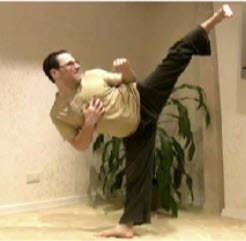
About the Author:
Paul Zaichik is an Exercise Science Expert, author of multitude of books, and the creator of Zaichik Stretching Technique (formely known as Kinesiological Stretching Technique). His speciality is flexibility training as well as body weight conditioning. His innovative method is designed to have maximum carry over into specific athletic techniques. Paul is the author of books and DVD’s on the topic of flexibility, martial arts and bodyweight training. Over the years, Paul Zaichik has worked with a variety of individuals including athletes, entertainers, and military personnel. His ElasticSteel Method of Athletic Conditioning programs, EasyFlexibility Programs and Zaichik Stretching Techniques are used world wide by both professional and amateurs with great success.
YOU MAY ALSO BE INTERESTED IN
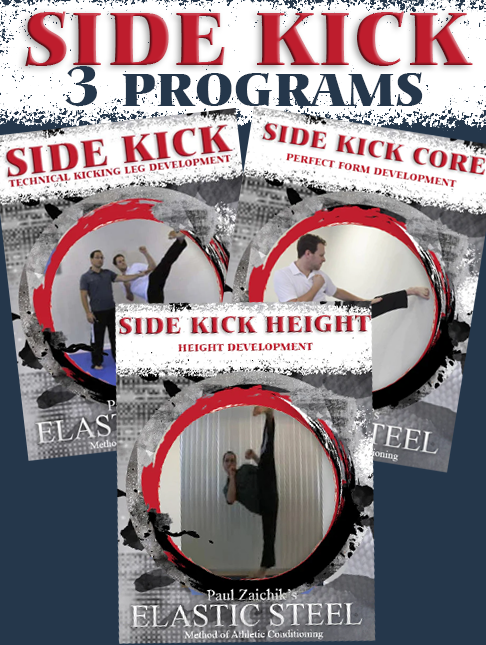
3 Program
Side Kick Combo
Side Kick Combo
This combo includes:
- Technical Kicking Leg Development
- Core Flexibility & Strength Development
- Height Development

7 Program
Side Kick Combo
Side Kick Combo
This combo includes:
- Technical Kicking Leg Development
- Core Flexibility & Strength Development
- Height Development
- Speed Development
- Precision & Accuracy Development
- Power Development
- Flying Side Kick
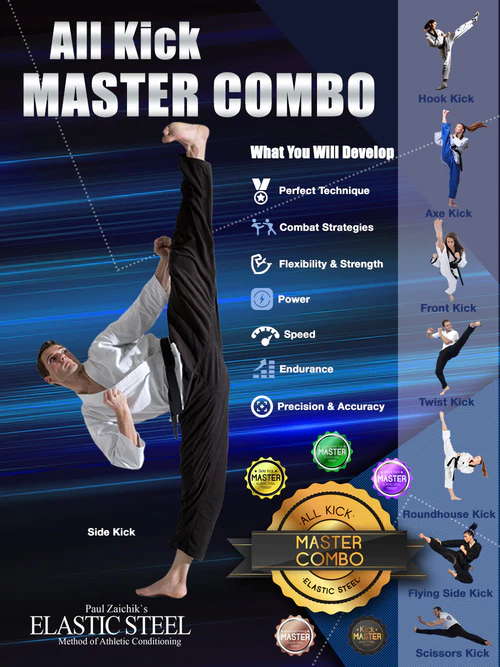
20 Program
All Kick Master Combo
+ 5 Gifts!
All Kick Master Combo
+ 5 Gifts!
This combo includes:
Side Kick:
- Technical Kicking Leg Development
- Core Flexibility & Strength Development
- Height Development
- Speed Development
- Precision & Accuracy Development
- Power Development
- Neutralizing Opponents Defense and Guard Penetration Set Ups
Roundhouse and Hook Kicks:
- Roundhouse Kick: Technical Kicking Leg Development
- Roundhouse Kick: Speed Development
- Roundhouse Kick: Power Development
- Hook Kick: Power Development
Front Kick:
- Front Kick and Front Line Kicks: Technical Kicking Leg Development
- Front Kick: Speed Development
- Push Front Kick: Power Development
- Axe Kick: Power Development
- Ball of the Foot: Point of Impact
Advanced Kicks:
- Scorpion Kick: Perfect form Development
- Flying Side Kick: Technique and Jumping Height Development
- Flying Split Scissors Kick, Two Direction Kick
- Twist Kick Technical Kicking Leg Development
- Twist Kick Follow Along Routine
+ 5 GIFTS!

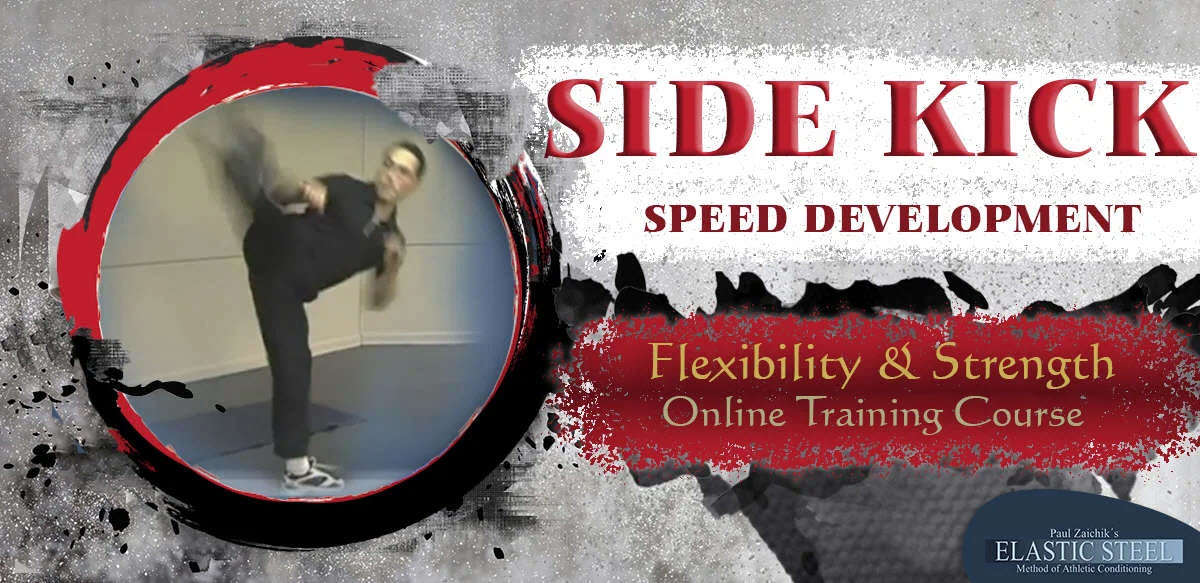
Leave a comment